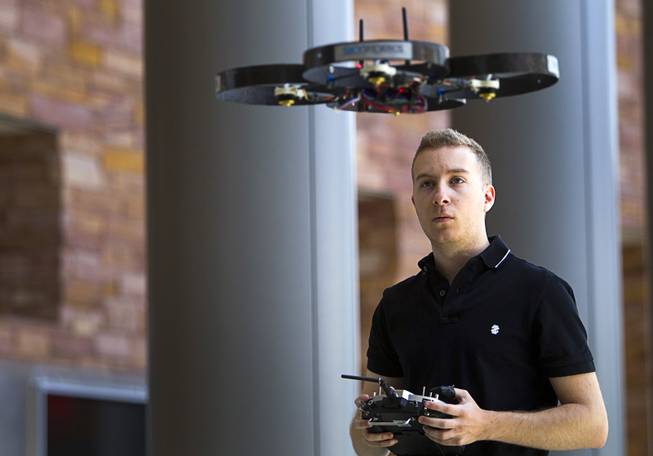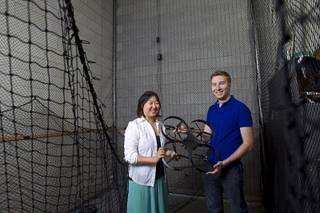
Skyworks co-founder and CEO Greg Friesmuth demonstrates his hand-made quadcopter drone Sunday, May 11, 2014, at UNLV.
Tuesday, May 13, 2014 | 2 a.m.
Inside UNLV’s science and engineering building and behind the unassuming wooden door of room B-164 is a place they call the cage.
Loose wires and drone parts litter desks that are squeezed around a rope-enclosed corner that gives it its nickname. It’s here the student-founded Skyworks Aerial Systems — one of Nevada’s most promising drone startups — calls home.
But not for much longer.
“The kids have grown up and have to move out,” jokes COO Jinger Zeng, who is also a mechanical engineering master's student.
Still, there is truth to her joke. UNLV mechanical engineering senior Greg Friesmuth founded Skyworks about a year ago. While most drone companies are waiting on the Federal Aviation Administration for regulations, Friesmuth and Zeng have decided to focus on indoor drone services.
The duo’s business model has won local and national awards as a startup company, and now they are on the ground floor as the drone industry gets ready to take off.
In the past two years, drones have gone from the talk of CES International to the streets of Las Vegas. They’ve been spotted above soccer fields and dayclub parties, at a business opening and in classrooms at UNLV.
With endless drone applications foreseen and cheaper options for consumers, it is only the beginning for drones.
“(Drones) are coming, but it’s taking some time because it’s a brand-new approach,” said Rama Venkat, dean of UNLV’s Howard R. Hughes College of Engineering. “In the next three or four years, drones will be in the community.”
Look, up in the sky!
Jason Roth was watching his son’s soccer practice in Anthem when he heard a faint buzzing.
The Henderson resident looked around for the source, but after seeing nothing unusual he moved on. That’s when his other son pointed to the sky, at a tiny drone hovering one field over. It was the first time Roth had ever seen a drone. He was amazed at its steadiness and ability to record the action while the man operated it on the field.
With drones available for less than $100, they have become popular products for amateur photographers, Friesmuth said.
Meanwhile, drones have been spotted capturing the action during the season-opening party at Hard Rock’s Rehab dayclub and at MGM Grand’s Wet Republic dayclub.
Michael Stuhmer works for the San Diego company, FromAbove, which supplied the drones for Rehab’s party.
Stuhmer, a San Diego real estate agent, works at the company his friend started as a hobby nine months ago. They mostly use a drone to take aerial photos of commercial and residential real estate property, but interest in their services quickly exploded.
They began getting requests to shoot other real estate properties, marathons, music festivals and parties.
“Everyone is talking about drones these days,” Stuhmer said. “It came out as these unmanned aerial vehicles in the Middle East blowing things up, but that’s not what it’s about. The app of drones is just endless.”
FromAbove has become a full-time business that connects drones with pilots to businesses interested in their services. Stuhmer said the company looking to expand its services to Las Vegas, where he sees interest exploding as drone testing takes off.
“Vegas has a big market and we wanted to move into that market,” Stuhmer said.
Friesmuth, who started building drones four years ago in his garage, said drones had exploded in popularity because the materials had become cheaper and smaller. His focus is on building indoor drones.
His most recent model is a quad-rotor drone with carbon-fiber barriers around the blades, which allows it to bounce off walls without damage.
He said Skyworks was focused on drone applications shaped around the three D’s: dirty, dangerous and dull.
He envisions drones not just flying around homes but used by firefighters to locate victims, inside mines for mapping and in areas to conduct radioactive testing.
“Aerial photography is a huge focus for most drone companies out there because it's the most lucrative target,” Friesmuth said. “One of the things that sets us apart is that we’re not building camera drones.”
Skywork's business model has turned heads in the startup community. Skyworks was a finalist in Chicago at the North American Professionals & Entrepreneurs Council conference, and the company's business plan earned $80,000 in the Southern Nevada Business Plan competition.
Skyworks even has a plan to produce educational drone kits to prepare a new generation of drone pilots.
“We’re filling a niche that (military) drones cannot provide,” Zeng said.
UNLV laying groundwork
While companies battle to gain a foothold in the drone industry, UNLV's engineering college is working to prepare a workforce for the drone industry.
The college will be introducing an unmanned aerial systems minor in the fall. The program requires three unique courses for drones on top of four classes engineering students already are required to take for their major.
Students will learn how to develop, operate, design and repair a drone, and what its applications are and can be. They’ll also take a law course to learn about Federal Aviation Administration regulations on drones, as well as privacy and Fourth Amendment law.
“Ultimately the minor makes engineering and computer science majors aware of (drones), which is growing, and making them employable for the industry,” Venkat said. “They will not go into this industry cold. They will be exposed to what a (drone) is, how to fly it, how to test it and simulate it.”
In the not-so-distant future Venkat envisions drones everywhere. He sees Metro using one to get an immediate live-feed of an emergency or hostage situation and a farmer using a drone to track crops or control cattle. Drones will be used to deliver packages, investigate gas and water pipes, or just as a hobby.
The FAA maintain flying an aircraft — manned or unmanned — in U.S. airspace needs some level of FAA approval, which would mean drone flyers are breaking the law. But a National Transportation Safety Board administrative judge has ruled otherwise. In a case involving the use of a drone to shoot footage for a college promotional video, the judge earlier this year ruled “there was no enforceable FAA rule” on the type of model aircraft used.
Meanwhile, the FAA continues to craft new rules on how small drones could be used legally for commercial purposes.
Still, more drones are coming. Sitting inside the office, Friesmuth sees drones as society’s new cell phone, growing from a luxury tech item to a personal necessity.
Pretty soon drones could be everywhere.



Join the Discussion:
Check this out for a full explanation of our conversion to the LiveFyre commenting system and instructions on how to sign up for an account.
Full comments policy